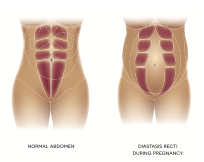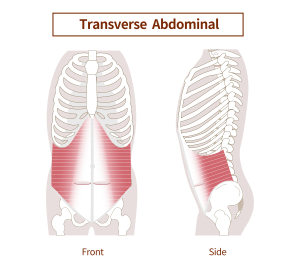A diastasis recti is a common problem that occurs in many women after pregnancy but is often not adequately addressed. It involves a separation of the rectus abdominis muscles, also known as the abdominal muscles, which occur during pregnancy and do not immediately return to their normal position after childbirth.

Causes and Symptoms
Why do you get diastasis recti?

During pregnancy, the uterus expands to accommodate the growing baby. This expansion can cause the rectus abdominis muscles to separate, creating a gap between them. This gap is referred to as diastasis recti. This can lead to a visible bulge in the abdominal area and impair posture, stability, and overall core strength.
What are the symptoms of diastasis recti?
The symptoms of diastasis recti can vary, but typical signs include a “bulge” or bulging in the abdomen when tensing or a depression in the middle of the abdomen, especially when the abdominal muscles are tensed. Women with diastasis recti may also experience back pain, weakened abdominal muscles, and problems with posture or control of the pelvic floor and bladder.
What should you not do with diastasis recti?
When dealing with diastasis recti, it’s important to avoid certain exercises and movements that increase intra-abdominal pressure and could worsen the separation of the abdominal muscles. These include:
- Sit-ups or crunches
- Movements that lift the head while lying on your back
- Getting up over the stomach without rolling to the side
- Any activities that require strong abdominal pressing
Diagnosis: Is there diastasis recti?
To determine if diastasis recti is present, you can take the following steps:
Self-test for diastasis recti: Lie on your back, bend your knees, and place your feet flat on the floor. Slightly lift your head and feel along the linea alba, from the sternum to the pubic bone. Do you feel a gap or indentation? If this gap is wider than two fingers, diastasis recti may be present.
Professional diagnosis: A doctor or physical therapist can provide a more accurate diagnosis and determine the severity of diastasis recti.
What can I do about diastasis recti?
Effective exercises for diastasis recti
Although it can be challenging, targeted exercises can help manage and even correct diastasis recti. Below are some effective exercises that can support the recovery process.

These exercises may seem very simple at first and as if they won’t help, but they are very effective. It is very important to initially strengthen the deep transverse abdominal muscle. Also, during all exercises, the navel should be pulled in, and the pelvic floor should be tightened. This way, the transverse abdominal muscle and pelvic floor are strengthened, and the brain learns to activate, control, and tense them again.
Basic principles for exercises with diastasis recti
- Focus on core stability: Strengthening the deeper core muscles, particularly the transversus abdominis (the deep transverse abdominal muscle), is crucial.
- Avoid pressure-increasing activities: Equally important as strengthening the deep abdominal muscles is avoiding certain exercises altogether: exercises that increase abdominal pressure, like sit-ups or crunches, can worsen the separation. Any movement that increases intra-abdominal pressure should be avoided, such as lifting the head in the supine position or getting up over the stomach. When lying down, always turn to the side first, sit up, and then get up with tightened abdominal and pelvic floor muscles. Even if it sounds like it won’t help much, these things are crucial to close the diastasis recti.
- Consistency is key: Regular, gentle exercises can gradually close the gap and strengthen the core.
The most effective exercises for closing diastasis recti

Transversus Abdominis Breathing – Belly Draw-In
- Instructions: Lie on your back, knees bent, and feet flat on the floor. Place your hands on your lower abdomen. Breathe deeply through your nose, so your belly rises. Exhale through your mouth while pulling your navel toward your spine. Hold this position for a few seconds, then release. This breathing technique is important because, during exhalation, the deep transverse abdominal muscle is automatically activated.
- Benefits: Activates and strengthens the deepest layer of abdominal muscles and promotes overall core stability.
With the exercise just described, you can activate the deep muscles. These are also called corset muscles because they run horizontally around the abdomen like a corset. Strong deep muscles hold the organs in place, help close the rectus diastasis, ensure a slim waist, and are crucial for maintaining the body’s health. You can activate and train them by repeatedly drawing in your belly button and engaging your pelvic floor throughout the day. Learn more about it here.
Pelvic Tilts
- Instructions: Lie on your back, knees bent, and feet flat on the floor. Inhale, and as you exhale, tilt your pelvis toward your ribs, so your lower back is flat on the floor. Hold this position for a few seconds, then release.
- Benefits: Engages the lower abdominal muscles and provides gentle core activation.
Heel Slides
- Instructions: Lie on your back, knees bent, and feet flat on the floor. Place your hands on your hip bones. Slowly slide one heel along the floor while exhaling until your leg is extended. Make sure your lower back remains flat on the floor. Return to the starting position and repeat with the other leg.
- Benefits: Improves coordination and control of the core muscles without excessive strain.
Single Leg Lifts
- Instructions: Lie on your back, knees bent, and feet flat on the floor. Exhale and tighten your abdominal and pelvic floor muscles. Slowly lift one leg while keeping the knee bent until the thigh is perpendicular to the floor. Lower it back down and repeat with the other leg. Only perform this exercise once a firm abdominal tension (by pulling in the navel) can be maintained.
- Benefits: Strengthens the lower abdominal muscles and improves core stability.
Tips for Success
- Consult a professional: Before starting an exercise program, especially after childbirth, consult a doctor or physical therapist who specializes in postpartum recovery. A recommended database to find specialized physiotherapists is rektusdiastase.info.
- Progress slowly: Start with simple exercises and gradually increase the intensity as core strength improves.
- Listen to your body: If an exercise causes pain or discomfort, stop immediately and consult a professional.
Conclusion
Diastasis recti can be a challenging condition, but with the right exercises and a consistent approach, it is possible to strengthen the core and realign the muscles. Remember that patience and perseverance are crucial. Integrate these exercises into your routine, and over time, you will notice significant improvements in your core strength and overall well-being.
Also, read my articles on diastasis recti and physiotherapy.
The articles on health topics do not replace a visit to the doctor. You can find more information here.

Sonja ist Ernährungswissenschaftlerin und promovierte Epidemiologin mit langjähriger Erfahrung in der Gesundheitsforschung. Seit der Geburt ihrer beiden Kinder 2019 und 2023 beschäftigt sie sich intensiv mit dem Thema Rückbildung und der Thematik, wie man wieder einen gesunden und schönen Körper mit stabiler Mitte nach der Schwangerschaft bekommen kann. Sie möchte Euch helfen, nach der Schwangerschaft wieder fit zu werden!